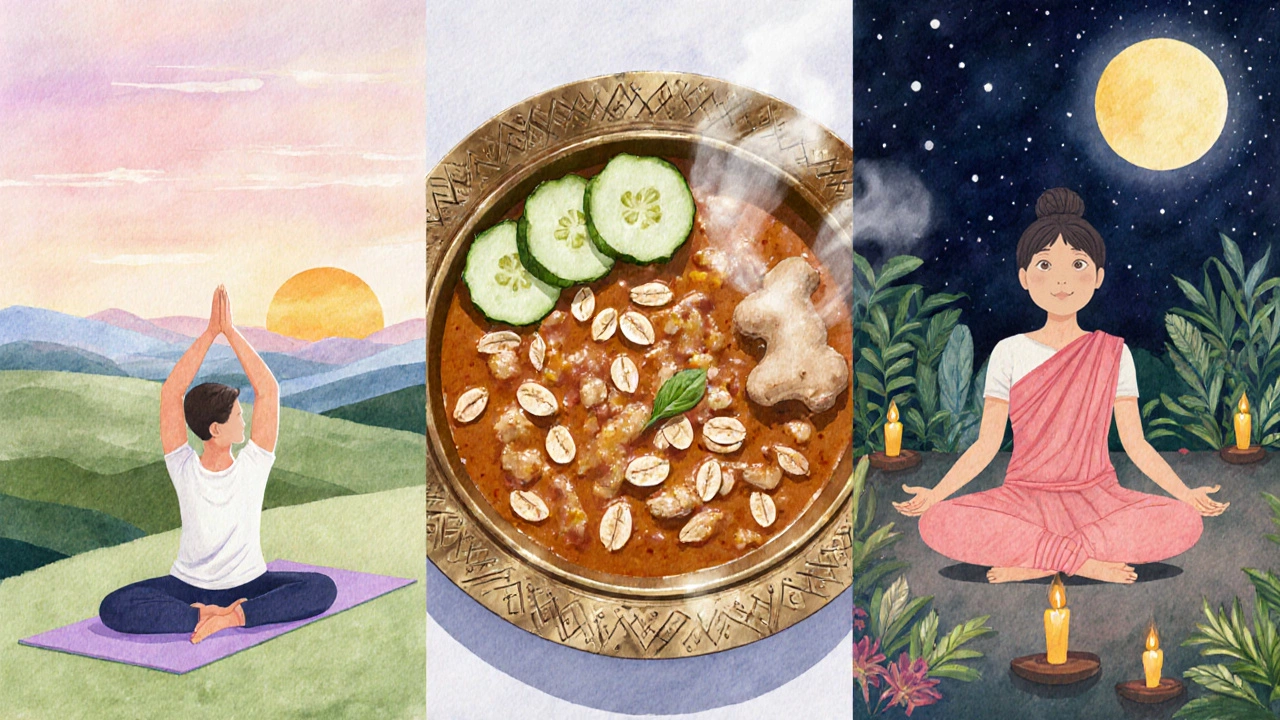Understanding the Golden Rule of Ayurveda: Balance, Health, and Everyday Practice
 Oct, 11 2025
Oct, 11 2025
Ayurveda Golden Rule Checkup Tool
Daily Ayurveda Golden Rule Assessment
Check which of these daily practices you've followed to honor the Ayurvedic golden rule of balancing doshas and nurturing Ojas.
Your Daily Balance Assessment
Key Takeaways
- The golden rule of Ayurveda is to maintain the balance of the three doshas-Vata, Pitta, and Kapha-through diet, routine, and mindset.
- Ojas, the essence of vitality, is the end result of consistent dosha harmony.
- Simple daily practices (Dinacharya) and mindful eating (Ahara) are the most practical ways to live the rule.
- Misunderstanding the rule as a single diet or herb leads to ineffective results.
- A quick checklist can help you assess whether you’re honoring the rule each day.
When people ask, Ayurveda golden rule, they’re really hunting for a single, easy‑to‑remember mantra that will make their health jump up a notch. The answer isn’t a magic pill; it’s a lifestyle philosophy that has guided Indian households for millennia. In this article we’ll unpack what the golden rule actually is, why it matters, and how you can weave it into modern life without turning your kitchen upside‑down.
Ayurveda is a traditional system of medicine from the Indian subcontinent that views health as a state of equilibrium among body, mind, and spirit. It classifies every person by a unique constitutional type called Prakriti, which is determined by the relative strengths of three fundamental energies known as Dosha. The goal of Ayurveda is to keep those doshas in balance, and the golden rule is the shortcut that tells you exactly how.
What the Golden Rule Actually Says
The rule can be summed up in one sentence: “Preserve the balance of the doshas and nurture Ojas to sustain health.” In plain English, that means you should aim for stable Vata, Pitta, and Kapha levels while feeding the body’s vital energy-Ojas-through constructive habits.
Why these two concepts? Ojas is described in classical texts as the subtle, nourishing essence that supports immunity, mental clarity, and longevity. It is produced when the doshas function harmoniously. If one dosha dominates, Ojas depletes, leading to fatigue, skin issues, and a weakened immune response.

Breaking Down the Core Entities
To live the golden rule, you need to recognize the players:
- Vata - the air‑and‑space element; governs movement, creativity, and the nervous system.
- Pitta - the fire‑and‑water element; controls digestion, metabolism, and body temperature.
- Kapha - the earth‑and‑water element; provides structure, lubrication, and stability.
- Agni - the digestive fire; a healthy Agni transforms food into energy and Ojas.
- Dinacharya - the daily routine that aligns activities with natural cycles.
- Ahara - the diet; choosing foods that pacify your dominant dosha.
- Ojas - the vital essence; the end product of balanced doshas and proper Ahara.
- Panchakarma - the detoxification series; supports dosha balance when needed.
How to Apply the Rule in Everyday Life
Applying the golden rule isn’t about memorizing a long list of herbs. It’s about three practical pillars:
- Align Your Daily Routine (Dinacharya)
- Wake up before sunrise if Vata is your dominant dosha; this calms excess air energy.
- Eat your largest meal at midday when Pitta’s fire is strongest, supporting optimal digestion.
- Finish work by early evening for Kapha types, preventing the heavy, sluggish feeling that builds after dusk.
- Choose Foods That Pacify Your Dominant Dosha (Ahara)
- Vata: warm, moist foods like cooked oats, stews, and ghee.
- Pitta: cooling foods such as cucumber, cilantro, and coconut water.
- Kapha: light, pungent items like ginger, black pepper, and leafy greens.
- Support Ojas Through Rest and Mindful Practices
- Prioritise 7-8 hours of sleep; deep sleep is where Ojas is regenerated.
- Practice gentle yoga or meditation for 10‑15 minutes daily to calm the mind and enhance Prana.
- Limit caffeine and alcohol, which can burn Agni and reduce Ojas.
When these three pillars are consistently honored, the doshas remain in harmonious motion, Agni stays strong, and Ojas flourishes.
Common Misconceptions About the Golden Rule
1. It’s a one‑size‑fits‑all diet. - False. The rule adapts to each individual’s Prakriti and seasonal changes.
2. Only herbs matter. - While Ayurvedic herbs are powerful, the rule emphasizes lifestyle first; herbs are adjuncts.
3. Balancing doshas means eliminating them. - Incorrect. The goal is to keep each dosha within its optimal range, not to erase it.

Quick Comparison of the Three Doshas
| Attribute | Vata | Pitta | Kapha |
|---|---|---|---|
| Element | Air & Ether | Fire & Water | Earth & Water |
| Physical Type | Light, thin, quick | Medium, muscular, sharp | Heavy, solid, steady |
| Emotional Tendencies | Creative, anxious | Ambitious, irritable | Calm, resistant |
| Digestive Strength | Irregular | Strong, can overheat | Slow, can stagnate |
| Seasonal Influence | Winter/Dry | Summer/Hot | Monsoon/Cold |
Daily Checklist to Honor the Golden Rule
- Did I wake up at a time that suits my dominant dosha?
- Did my main meal include foods that pacify my dominant dosha?
- Did I drink enough warm water and avoid excessive cold drinks?
- Did I allocate at least 7 hours for restful sleep?
- Did I spend 10 minutes in meditation or gentle movement?
- Did I end the day with a light, easily digestible dinner?
Frequently Asked Questions
What is the difference between Prakriti and Vikriti?
Prakriti is your innate constitutional makeup-the baseline balance of Vata, Pitta, and Kapha you’re born with. Vikriti describes the current, often imbalanced state caused by diet, stress, or environment. The golden rule focuses on moving Vikriti back toward Prakriti.
Can the golden rule be applied to children?
Yes. For kids the emphasis is on gentle routines-regular meals, adequate sleep, and play that matches their dosha. Heavy detox practices like Panchakarma are reserved for adults under professional guidance.
How does season affect the golden rule?
Seasonal shifts can aggravate a particular dosha: cold, dry winters increase Vata; hot summers amplify Pitta; damp monsoons boost Kapha. Adjusting Dinacharya-like warmer foods in winter or lighter meals in summer-keeps the rule in balance.
Is Ojas the same as immunity?
Ojas is broader than immunity. It includes physical strength, mental clarity, youthful glow, and emotional resilience. Strong Ojas usually means a robust immune system, but it also supports vitality in everyday activities.
Do I need an Ayurvedic practitioner to follow the golden rule?
A practitioner can give personalized guidance, especially if you have chronic conditions. However, the core principles-balanced diet, regular routine, and Ojas‑supporting habits-are accessible to anyone willing to pay attention to their body’s signals.
By keeping the three doshas in harmony and nourishing Ojas, you’re essentially living the golden rule of Ayurveda. It’s a lifelong practice, not a quick‑fix, but the payoff is a steadier mind, stronger body, and a sense of inner balance that modern life often steals away.